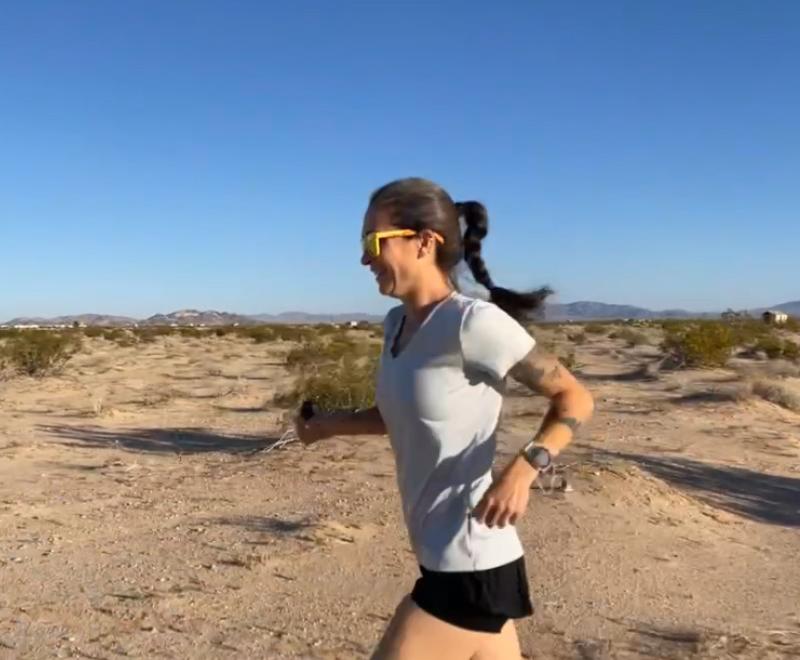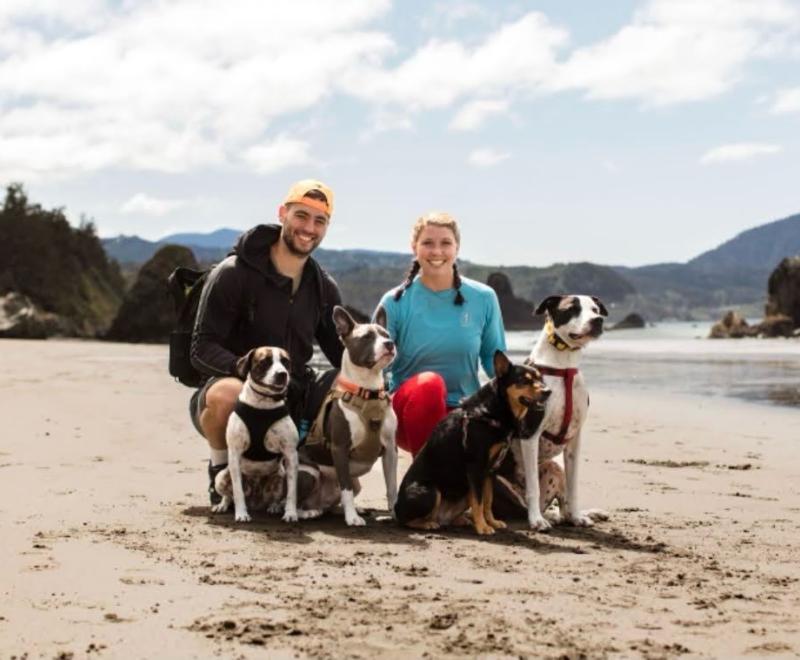Runners face a desert challenge to help animals

When someone asked English mountaineer George Mallory back in 1921 why he wanted to climb Mount Everest, his answer was a succinct “Because it is there.”
With that in mind, the mere existence of the Grand to Grand Ultra footrace might be sufficient motivation for some Best Friends supporters and employees to test themselves in harsh desert conditions. Or it could have been one particular Best Friends co-founder who paved the way.
In 2014, Gregory Castle, then 72, completed the challenging, seven-day, self-supported footrace, which begins at the north rim of the Grand Canyon, passes through Best Friends Animal Sanctuary, and finishes at Pink Cliffs, the top layer of the Grand Staircase-Escalante National Monument.
Gregory’s feat fueled more people’s interest in taking up the challenge. This year, five individuals participating under the Best Friends banner will join 56 other endurance athletes from around the world in the race’s 11th edition, beginning September 22.
Bart Battista, senior director of canyon operations; Maureen Gillespie, junior data scientist; Ben Oriordan-Tingley, lifesaving and care specialist; and Noël and Josh Voigt, supporters of Best Friends, will traverse 171 miles and climb 18,000 feet from beginning to end. They will carry their own water (replenished at stations along the way) and at the end of each day rest and recuperate at campsites.
Second time around
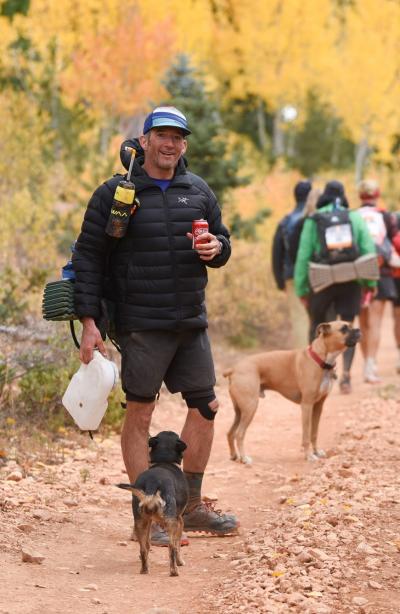
For Bart Battista, it will be his second Grand to Grand Ultra, following a first go-round in 2019. A 20-year Marine Corps veteran with an athletic background that includes rugby, boxing, and outrigger canoe racing in Hawaii and California, he’s run numerous 5Ks, 10Ks, and half and full marathons — including the Mt. Fuji Ekiden in Japan, a 29-mile relay race in which runners climb 10,495 feet before descending back down the mountain. “By far the coolest race I’ve ever been in,” he says.
Bart’s training for the upcoming race includes recently running the Bears Ears Ultra 50K in Utah’s Abajo Mountains and the Grand Mesa Ultra 50-miler in Colorado. But the Grand to Grand has its own unique challenges, says Bart. “You have to deal with limited nutrition, and you carry only about a liter and a half (about 6 cups) of water at a time (between aid station fill-ups every 6-9 miles). It’s critical that you carefully manage your physical activity because if you push too hard and sweat too much, you can bonk and drop out. There were some amazing athletes back in 2019 who didn’t finish because they pushed themselves too hard.”
A highlight for Bart will be experiencing the camaraderie among participants from all over the world (15 different countries this year). “We all like the physical challenge and the competition,” he says. “But making friends during the seven days is a big part of it. For most of us, it’s not about winning. Back in 2019, we were just trying to finish.”
Because the race passes through the Sanctuary, Bart leads the Best Friends effort on logistical support as part of his job. “The Grand to Grand is a great event, and Best Friends has been connected with it since its inception,” he says. “It’s very generous of the race to give us five free entries this year in recognition of the support we provide. Plus, we are one of the nonprofits they donate to at the end of the race.”
Her 40th birthday challenge
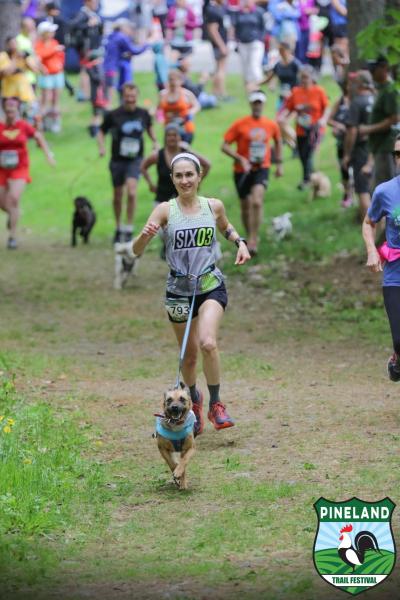
Maureen Gillespie, a former university professor and high school cross-country coach, has been a runner since she was 12. In addition to competing in 100-milers and countless other long-distance competitions, she’s run the Boston Marathon three times. She also loves competing in “canicross” (a combination of “canine” and “cross-country”) in which runners and their dogs compete in a 5K trail race.
“Since I just turned 40 last month, I wanted to do something special for my birthday,” Maureen says. “The Grand to Grand is it!”
Maureen had never heard of Best Friends until she took a trip to Utah back in 2022 in search of a dog-friendly area for hiking and running. “My whole life I’ve had a special connection with animals. As a child, I always had a cat under one arm while I was training my dog to do a new trick. After adopting my two hound dogs, Tulah and Zorro, I began volunteering as a foster caregiver and helping with adoption.”
With that kind of background, Maureen was soon volunteering with Best Friends. “I spent about a month volunteering at the Sanctuary, running the trails through the canyons, and hiking with my dogs,” she says. “That’s when I decided to become involved with Best Friends and its mission. I started doing remote volunteer work, and a year later I was offered my current job on the enterprise analytics team.”
“I’m really looking forward to running in the Grand Canyon,” she says. “And getting to run through Best Friends in the middle of the race, I think, is going to be really, really special.”
Maureen often runs races for charity, and she says it’s the thought of a good cause that gets her through her most difficult races. “Some of my biggest races have been with fundraising in mind,” she says. “I think about all the folks who volunteer, who donate, and who support me because they care about what I’m doing. I’m doing this for something bigger than just my own finish line.”
From the U.K. to Utah
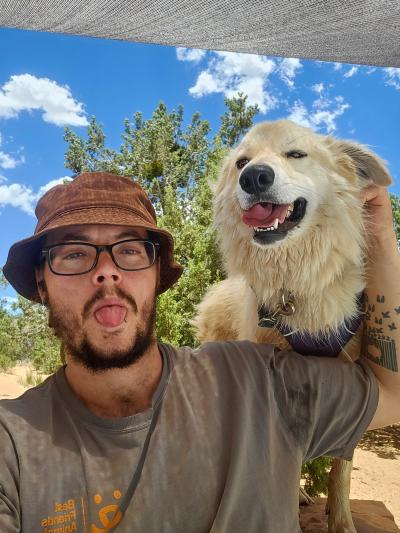
Ben Oriordan-Tingley was encouraged to pursue his love for animals by his English grandmother, who worked with an international animal welfare organization. So it figures that when he came to the United States in 2014, it was to accept an animal welfare internship in California. “Working with animals and the land is something that I’ve always felt driven to do,” he says.
Working at Best Friends in Dogtown, Ben knows all the trails and enjoys training for the upcoming race in his own backyard. Part of his training consists of running on his lunch hour while wearing a 20-pound weight vest. “Sometimes I’ll run from Dogtown to Angel Village Café and back. It’s good practice. Then I’ll run and walk in the evenings. I’ve been training in chunks of time rather than long stretches.”
“I primarily work with dogs but have an affinity, care, and respect for animals of all kinds,” he says. “I’ve worked with rescued farm animals, and they hold a special place in my heart. I can only hope that we as a species do our best to make right and be good to the beings we share this planet with.”
Ben says he wasn’t much of an athlete growing up. “But in my late teens I got into backpacking, which gave me a deeper appreciation for nature. And it definitely pushed me more physically. A few years back, I started doing Spartan Races (long-distance obstacle courses). My first Spartan was a 10K, and then I started doing more and longer races. I did the Rim2Rim (Grand Canyon south rim to north rim). And my first ultra was a 30-miler.”
As the race approaches, he’s doing long-distance runs on the weekends to get himself as physically fit as possible for the challenge. “I think the biggest test will be finding out if my body will hold up,” he says. “But overall I’m excited for the challenge of the race and everything it presents: the chance to drop out of society, flow into the grind, get more in touch with myself, test my abilities, and push myself in a way I never have — all while being surrounded by the beauty of the high desert.
Virginia couple runs for the animals
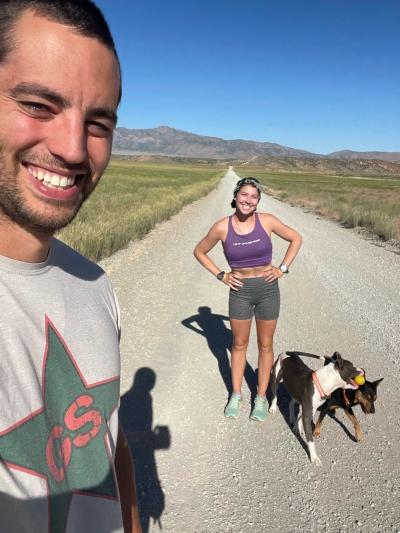
Josh and Noël Voigt, who have four dogs (Reis, Turk, Robin, and Sully) and are active animal rescue volunteers in Virginia, are devoted supporters of Best Friends. They are also runners — especially Noël, a medical administrative assistant with a long list of races to her credit, including the Forgotten Florida 100-miler (twice) and, most recently, the Badger 100 in Wisconsin. Josh has completed the Spartan Race Trifecta, in which participants run three races (5K, 10K, and 21K) while jumping over 10, 25, and 30 obstacles, respectively.
But their pièce de résistance was Noël’s U.S. coast-to-coast run last year via a circuitous route that covered 8,000 miles. She set out May 22, 2023, in Port Orford, Oregon, and finished December 8, 2023, in Cedar Island, North Carolina. They took many turns and detours along the way that led them along historic paths, including the TransAmerica Trail.
Running with Noël across the country, every step of the way, was her dog Robin. “If I ran 8,000 miles, I’m sure Robin ran 16,000,” she says, “because she always runs out and then comes back to check on me.” And Josh, a professional strength and conditioning coach, did the driving and handled support duties.
Noël is a strong advocate for pushing boundaries, which she says provides the motivation she needs to manage four autoimmune diseases. And because she always must run with a partner, Josh will accompany her on the upcoming adventure through the desert. And the two members of Team Voigt insist they’ll be sticking together.
“Or at least until the end,” says Noël. “We’re both really competitive. So on that last day right at the end, each of us might, you know, just take off.”
Let's make every shelter and every community no-kill in 2025
Our goal at Best Friends is to support all animal shelters in the U.S. in reaching no-kill in 2025. No-kill means saving every dog and cat in a shelter who can be saved, accounting for community safety and good quality of life for pets.
Shelter staff can’t do it alone. Saving animals in shelters is everyone’s responsibility, and it takes support and participation from the community. No-kill is possible when we work together thoughtfully, honestly, and collaboratively.
